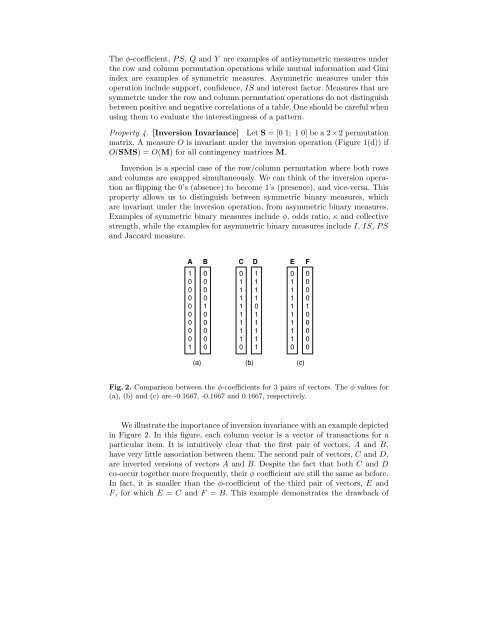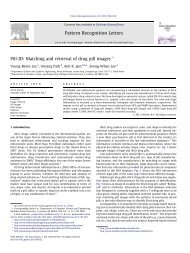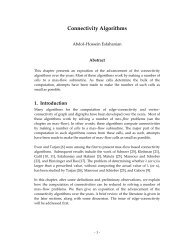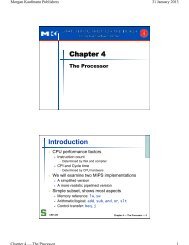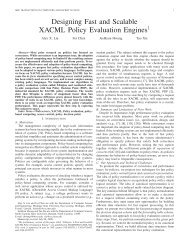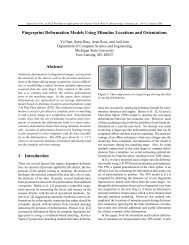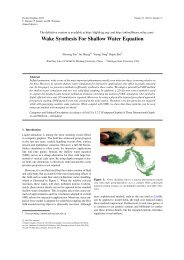Selecting the Right Objective Measure for Association Analysis*
Selecting the Right Objective Measure for Association Analysis*
Selecting the Right Objective Measure for Association Analysis*
You also want an ePaper? Increase the reach of your titles
YUMPU automatically turns print PDFs into web optimized ePapers that Google loves.
The φ-coefficient, P S, Q and Y are examples of antisymmetric measures under<br />
<strong>the</strong> row and column permutation operations while mutual in<strong>for</strong>mation and Gini<br />
index are examples of symmetric measures. Asymmetric measures under this<br />
operation include support, confidence, IS and interest factor. <strong>Measure</strong>s that are<br />
symmetric under <strong>the</strong> row and column permutation operations do not distinguish<br />
between positive and negative correlations of a table. One should be careful when<br />
using <strong>the</strong>m to evaluate <strong>the</strong> interestingness of a pattern.<br />
Property 4. [Inversion Invariance] Let S = [0 1; 1 0] be a 2×2 permutation<br />
matrix. A measure O is invariant under <strong>the</strong> inversion operation (Figure 1(d)) if<br />
O(SMS) = O(M) <strong>for</strong> all contingency matrices M.<br />
Inversion is a special case of <strong>the</strong> row/column permutation where both rows<br />
and columns are swapped simultaneously. We can think of <strong>the</strong> inversion operation<br />
as flipping <strong>the</strong> 0’s (absence) to become 1’s (presence), and vice-versa. This<br />
property allows us to distinguish between symmetric binary measures, which<br />
are invariant under <strong>the</strong> inversion operation, from asymmetric binary measures.<br />
Examples of symmetric binary measures include φ, odds ratio, κ and collective<br />
strength, while <strong>the</strong> examples <strong>for</strong> asymmetric binary measures include I, IS, P S<br />
and Jaccard measure.<br />
A B C D<br />
1<br />
0<br />
0<br />
0<br />
0<br />
0<br />
0<br />
0<br />
0<br />
1<br />
0<br />
0<br />
0<br />
0<br />
1<br />
0<br />
0<br />
0<br />
0<br />
0<br />
0<br />
1<br />
1<br />
1<br />
1<br />
1<br />
1<br />
1<br />
1<br />
0<br />
1<br />
1<br />
1<br />
1<br />
0<br />
1<br />
1<br />
1<br />
1<br />
1<br />
E<br />
0<br />
1<br />
1<br />
1<br />
1<br />
1<br />
1<br />
1<br />
1<br />
0<br />
F<br />
0<br />
0<br />
0<br />
0<br />
1<br />
0<br />
0<br />
0<br />
0<br />
0<br />
(a)<br />
(b)<br />
(c)<br />
Fig. 2. Comparison between <strong>the</strong> φ-coefficients <strong>for</strong> 3 pairs of vectors. The φ values <strong>for</strong><br />
(a), (b) and (c) are -0.1667, -0.1667 and 0.1667, respectively.<br />
We illustrate <strong>the</strong> importance of inversion invariance with an example depicted<br />
in Figure 2. In this figure, each column vector is a vector of transactions <strong>for</strong> a<br />
particular item. It is intuitively clear that <strong>the</strong> first pair of vectors, A and B,<br />
have very little association between <strong>the</strong>m. The second pair of vectors, C and D,<br />
are inverted versions of vectors A and B. Despite <strong>the</strong> fact that both C and D<br />
co-occur toge<strong>the</strong>r more frequently, <strong>the</strong>ir φ coefficient are still <strong>the</strong> same as be<strong>for</strong>e.<br />
In fact, it is smaller than <strong>the</strong> φ-coefficient of <strong>the</strong> third pair of vectors, E and<br />
F , <strong>for</strong> which E = C and F = B. This example demonstrates <strong>the</strong> drawback of


